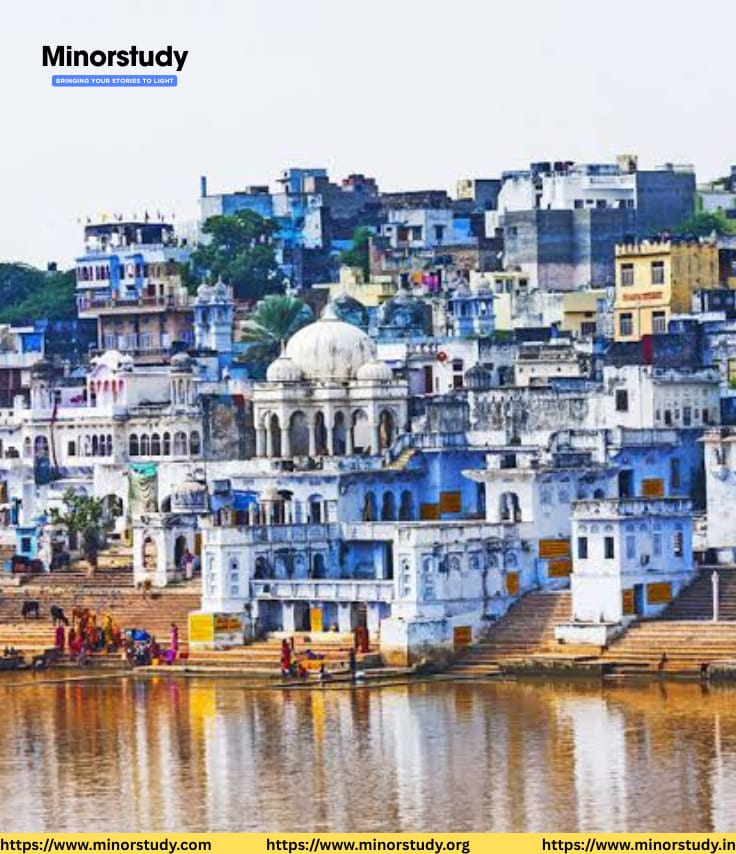🪷 Introduction: A Lake that Speaks to the Soul
Pushkar Lake: Nestled in the small yet sacred town of Pushkar in Rajasthan, Pushkar Lake is not just a waterbody — it’s a spiritual universe, a place where the divine meets the earthly, and where countless pilgrims come in search of peace, blessings, and rebirth.
- 📜 History of Pushkar Lake
- 🗓️ Timeline of Pushkar Lake
- 📊 Fascinating Facts About Pushkar Lake
- ❓ Frequently Asked Questions (FAQs)
- Q: Why is Pushkar Lake considered sacred?
- Q: What is the best time to visit Pushkar Lake?
- Q: Is the lake artificial or natural?
- Q: Can non-Hindus visit the lake?
- 🛕 Observance & Spiritual Significance
- 💝 Heartfelt Wishing
- 📌 Key Points to Remember
- 💫 Daily Life Impact
- 👨👩👧👦 1. Spiritual Cleansing
- 🧘 2. Meditation and Inner Peace
- 💼 3. Economic Boost
- 🌿 4. Environmental Sensitivity
- 🌍 Importance in Society
- 🧠 Conclusion: A Lake that Transcends Time and Faith
Surrounded by 52 ghats and 500+ temples, and wrapped in mythological grandeur, Pushkar Lake is one of the oldest and holiest pilgrimage sites in India. It is deeply rooted in Hindu, especially Brahma worship, and is often compared to Lake Mansarovar for its holiness.
This article dives deep into the history, facts, timeline, spiritual essence, and why Pushkar Lake holds a transformational significance in Indian life and society.
📜 History of Pushkar Lake
Pushkar Lake’s history is intimately tied to Lord Brahma, the creator in the Hindu Trinity (Trimurti). According to legend:
Lord Brahma dropped a lotus flower on Earth while performing a yajna (fire ritual), and the flower fell in Pushkar, creating the sacred lake.
The name “Pushkar” is derived from Sanskrit: “Pushpa” (flower) + “Kar” (hand).
🔱 Ancient Mentions:
Referenced in Ramayana, Mahabharata, and the Puranas, showing its antiquity.
Adi Shankara visited Pushkar to revive the spiritual values associated with Brahma worship.
The lake is surrounded by temples, including the famous Brahma Temple, one of the very few in the world.
🗓️ Timeline of Pushkar Lake
| Period | Event |
|---|---|
| Vedic Era | Mentioned in Vedas and Puranas; believed to be created by Lord Brahma |
| 2nd Century BCE | Became a key pilgrimage for sages, monks, and Brahmins |
| 7th–12th Century CE | Temples built around the lake; flourishing spiritual center |
| 1600s | Reconstructed by Maharaja Man Singh of Amber |
| Modern Era | Became a global attraction due to its spiritual and cultural energy |
📊 Fascinating Facts About Pushkar Lake
🌺 One of the five most sacred pilgrimage lakes in Hinduism, along with Manasarovar and Pampa Sarovar.
🛕 Only Brahma Temple in India is located on its bank — an extremely rare site of creator worship.
💧 It is believed that taking a dip during Kartik Purnima washes away all sins and grants moksha (liberation).
🌍 Over 100,000 pilgrims gather during the Pushkar Fair to bathe in the lake.
🕊️ Mahatma Gandhi’s ashes were also sprinkled in Pushkar Lake as a sign of sacred farewell.
❓ Frequently Asked Questions (FAQs)
Q: Why is Pushkar Lake considered sacred?
Answer: It is believed to have been formed by the tears of Lord Brahma’s lotus. Bathing in the lake during auspicious occasions is thought to purify karma and bestow salvation.
Q: What is the best time to visit Pushkar Lake?
Answer: October to November, especially during Kartik Purnima, is the most spiritual and visually vibrant time due to the Pushkar Camel Fair and holy bath rituals.
Q: Is the lake artificial or natural?
Answer: It is a natural holy lake, believed to be of divine origin, surrounded by ghats built by different rulers over centuries.
Q: Can non-Hindus visit the lake?
Answer: Yes. Non-Hindus are welcome and often participate respectfully in the rituals and photography, though swimming is usually avoided outside of ritual bathing.
🛕 Observance & Spiritual Significance
🌕 Kartik Purnima Bathing Ritual
Occurs on the full moon of Kartik month (Oct–Nov).
Thousands of devotees from all over India gather to bathe in the lake’s 52 ghats.
It is believed that even gods descend to Pushkar Lake on this day to purify themselves.
🔱 Brahma Worship
The only major Brahma Temple in the world is next to the lake.
Special pujas and homams (fire rituals) are performed near the lake throughout the year.
🐪 Pushkar Fair
The Pushkar Mela is a mega cultural and livestock fair, where religious, cultural, and trade activities blend.
It ends with pilgrims taking a holy dip in Pushkar Lake.
💝 Heartfelt Wishing
🌼 May the divine waters of Pushkar Lake cleanse your soul, heal your heart, and fill your life with inner calm and cosmic blessings. May your visit to this holy place bring you peace, prosperity, and the joy of spiritual discovery. 🕉️
📌 Key Points to Remember
🔹 Associated with Lord Brahma and moksha (liberation)
🔹 Hosts 52 ghats and over 500 temples
🔹 Takes center stage during Kartik Purnima
🔹 Strong blend of spirituality, culture, and devotion
💫 Daily Life Impact
👨👩👧👦 1. Spiritual Cleansing
Pushkar Lake is visited by millions of devotees annually, making it a living center of spiritual purification and cultural exchange.
🧘 2. Meditation and Inner Peace
Modern-day spiritual seekers and yoga practitioners use the banks of the lake for reflection and inner work.
💼 3. Economic Boost
The Pushkar Fair and regular tourism boost local employment — artisans, hoteliers, tour guides, priests, and traders thrive because of the lake.
🌿 4. Environmental Sensitivity
It fosters eco-awareness, as locals and NGOs strive to maintain its sanctity against pollution and over-tourism.
🌍 Importance in Society
Pushkar Lake is a microcosm of India’s spiritual ecosystem:
🛕 Promotes unity in diversity, with people from all over the country gathering together.
🙏 Encourages spiritual tourism, supporting India’s cultural identity.
📿 Inspires charity, community care, and public hygiene during massive pilgrimages.
🌸 Reflects India’s mythological continuity, connecting modern society to ancient narratives.
🧠 Conclusion: A Lake that Transcends Time and Faith
Pushkar Lake is not just a destination; it’s a living legend. It whispers tales from the Vedas, holds prayers in its waves, and mirrors the soul of Indian spirituality. For the religious, it’s a site of redemption; for the tourist, a site of curiosity and awe; and for the seeker, a sanctuary of silence and realization.
It is water that heals. A lake that listens. A place that transforms.









I like what you guys are up also. Such smart work and reporting! Carry on the superb works guys I¦ve incorporated you guys to my blogroll. I think it’ll improve the value of my web site 🙂